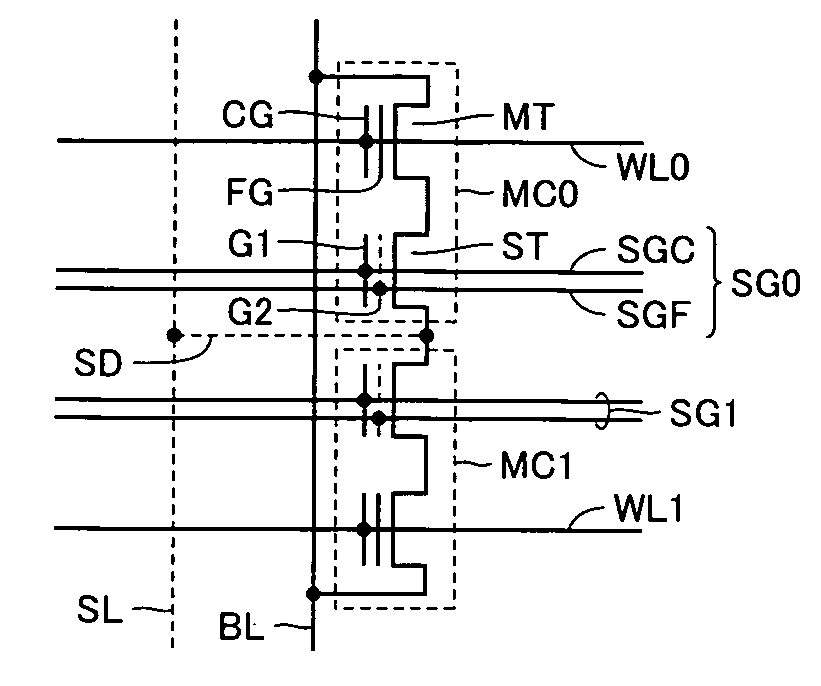Nonvolatile semiconductor memory device
a semiconductor and memory device technology, applied in semiconductor devices, digital storage, instruments, etc., can solve the problems of excessive extraction of electrons, erroneous reading, and need to consider “over-erasure” and other problems, to achieve the effect of low current consumption and high speed
- Summary
- Abstract
- Description
- Claims
- Application Information
AI Technical Summary
Benefits of technology
Problems solved by technology
Method used
Image
Examples
embodiment 1
[0063]FIG. 1 is a diagram showing an electrical equivalent circuit of memory cells according to Embodiment 1 of the present invention. In FIG. 1, memory cells MC0 and MC1 of two bits are shown representatively. Since memory cells MC0 and MC1 have the same construction, reference numerals are allotted to components of memory cell MC0 in FIG. 1. Memory cell MC0 includes a memory transistor MT and a selection transistor ST which are connected in series between a bit line BL and a source line SL. Memory transistor MT includes a floating gate FG that stores information in the form of electric charges and a control gate CG formed above floating gate FG and connected to a word line WL0. Control gate CG is used to refer to a gate electrode arranged for each individual memory cell and word line WL (WL0, WL1) is used to refer to an interconnection line arranged extending continuously in a row direction for one row of memory cells and connecting to the control gates of the memory cell transist...
embodiment 2
[0177]FIG. 25 is a diagram schematically showing a construction of a nonvolatile memory cell array according to Embodiment 2 of the present invention. In FIG. 25, memory cells MC0 to MC3 of four bits disposed in alignment in one column are representatively shown. These memory cells MC0 to MC3 are connected to bit line BL in common and are connected to source line SL in common. These memory cells MC0 to MC3 are connected between bit line BL and source line SL in parallel each other.
[0178] Each of memory cells MC0 to MC3 has a three-layered gate structure and includes floating gate FG, and first and second control gate electrodes CG1 and CG2. For these memory cells MC0 to MC3, word lines WL0 to WL3 are arranged, respectively. Each of word lines WL0 to WL3 is connected to the memory cells arranged in alignment in one row in common.
[0179] Each of word lines WL0 to WL3 includes a word control line WCL and a word selection line WSL coupled to first and second control gate electrodes CG1...
embodiment 3
[0215]FIG. 33 is a diagram schematically showing a construction of a main portion of a nonvolatile semiconductor memory device according to Embodiment 3 of the present invention. In FIG. 33, a bottom N well 92 is provided in a circumference (outer periphery) of a p-type well 90. In p-type well 90, memory cells MC are formed, and word lines, bit lines and source lines are arranged corresponding to the memory cells. Namely, p-type well 90 is used for forming the memory cells.
[0216] Memory cell MC may be a stacked gate transistor having a floating gate (FG), or may be configured to have a charge trap film (ONO film). The floating gate and the charge trap film are collectively referred to as an electric charge accumulation region.
[0217] To bottom N well 92A, a well voltage Vnw from a bottom voltage generating circuit 94 is supplied, and to p-type well 90, a well voltage (substrate voltage) Vpw from a well voltage generating circuit 96 is supplied.
[0218]FIG. 34 is a diagram schematica...
PUM
 Login to View More
Login to View More Abstract
Description
Claims
Application Information
 Login to View More
Login to View More - R&D
- Intellectual Property
- Life Sciences
- Materials
- Tech Scout
- Unparalleled Data Quality
- Higher Quality Content
- 60% Fewer Hallucinations
Browse by: Latest US Patents, China's latest patents, Technical Efficacy Thesaurus, Application Domain, Technology Topic, Popular Technical Reports.
© 2025 PatSnap. All rights reserved.Legal|Privacy policy|Modern Slavery Act Transparency Statement|Sitemap|About US| Contact US: help@patsnap.com



